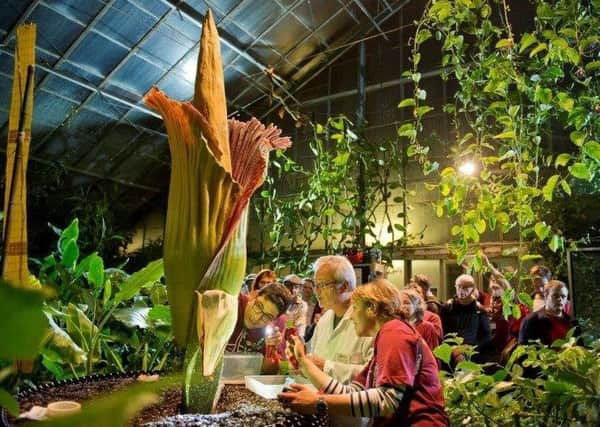Axel Dalberg Poulsen and Mark Hughes: Headline-grabbing Titan helps, but the plants that sustain us need attention too


Although the rather wet weather of early August slowed down the crowds of visitors, compared to when the plant first flowered two years ago, this had a beneficial effect. Combined with the decision to open late over the first two nights of bloom, the steady pace of visitors made it possible for individuals – from toddlers up – to have better interaction with our staff and volunteers of the ‘Titan Army’. Visitors learned how tropical botanists and horticulturists work in the field, how living and pressed collections are looked after, and how we apply reproductive and molecular methods to help conserve this flagship species. This statuesque botanical star reflected all the activities of RBGE: science, horticulture, art, conservation and education. It was a magical, transfixing entity capable of enthusing young and old and providing RBGE with an opening talk about our work and why it matters.
Nurturing this plant to the point of bloom twice in the space of three years takes a skilled team of horticulturists, who themselves have grown to understand every quirk of its development. To the uninitiated, the bud emerging from the top of the record breaking 153 kg+ corm looked like a small head of chicory. The plant only grows a single leaf or a single flower each year – but this year, which was it? Even at a very early stage, one of our horticulturists commented she would stake her house on it being a flower: the small bud was slightly more in the centre than we would expect of a leaf and a subtly different shape. She was proved correct when, several weeks later, the bracts fell to reveal the frilly skirt of a developing spadix.
Advertisement
Hide AdAdvertisement
Hide AdArtists are also inspired by this remarkable bloom, and our life-size triptych of its development and blooming is currently on display as part of our summer exhibition Plant Scenery of the World in Inverleith House. As the exhibition celebrates 50 years of our modernist Front Range Glasshouses, our Amorphophallus couldn’t have better timed its arrival centre stage.


The week following the bloom, hundreds of visitors added their own interpretation of the triptych by joining in a range of fun activities in the Fletcher Building and creating a crowd-sourced mosaic of countless 10cm squares.
Scientifically, our Amorphophallus begs further investigation. The species was originally introduced to horticulture in 1878 by the Italian botanist Odoardo Beccari, who collected seeds and a corm in Sumatra, the native home of the species. That corm was destroyed at customs – a case of plus ca change for our staff who invest considerable resources in staying up-to-speed with of plant movement regulations – but the seeds survived and germinated. So, are all the plants currently in cultivation around the world from this one introduction? Are many of them even a single clone, propagated by cuttings as the species passed from garden to garden? We are planning a DNA fingerprinting programme to assess how much genetic diversity is held in collections of the species in botanic gardens, to inform our pollen sharing decisions.
As a tool for enthusing, educating and connecting people and plants, the Amorphophallus is a headline attraction and helps bring people into contact with nature who may not usually get excited about plants. It is worth remembering that this is just one of the 13,500 species of plants in our care at our four Scottish Gardens of Inverleith, Benmore, Dawyck and Logan; each one of these species also comes with a history, a story, a value to science and conservation. We remain an institute truly global in outlook, collaborating with 70 over countries on our mission to explore, explain and conserve the world of plants. In a world where bad news days seem to come thick and fast, it may help to reflect that every day here in Scotland RBGE takes incremental steps forward in securing a better future for the plants that sustain us. Join us in celebrating this, and take pleasure in some of the thousands of species we look after – all it takes is a visit.
Dr Axel Dalberg Poulsen is a Research Associate and Dr Mark Hughes is a Tropical Botanist, Royal Botanic Garden Edinburgh